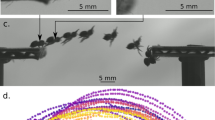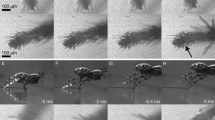Abstract
Spiders use hemolymph pressure to extend their legs. This mechanism should be challenged when required to rapidly generate forces during jumping, particularly in large spiders. However, effective use of leg muscles could facilitate rapid jumping. To quantify the contributions of different legs and leg joints, we investigated jumping kinematics by high-speed video recording. We observed two different types of jumps following a disturbance: prepared and unprepared jumps. In unprepared jumps, the animals could jump in any direction away from the disturbance. The remarkable directional flexibility was achieved by flexing the legs on the leading side and extending them on the trailing side. This behaviour is only possible for approximately radial-symmetric leg postures, where each leg can fulfil similar functions. In prepared jumps, the spiders showed characteristic leg positioning and the jumps were directed anteriorly. Immediately after a preliminary countermovement in which the centre of mass was moved backwards and downwards, the jump was executed by extending first the fourth and then the second leg pair. This sequence provided effective acceleration to the centre of mass. At least in the fourth legs, the hydraulic and the muscular mechanism seem to interact to generate ground reaction forces.













Similar content being viewed by others
References
Ahn AN, Full RJ (2002) A motor and a brake: two leg extensor muscles acting at the same joint manage energy differently in a running insect. J Exp Biol 205:379–389
Alexander RM (1977) Mechanics and scaling of terrestrial locomotion. In: Pedley T (ed) Scale effects in animal locomotion. Academic Press, London, pp 93–110
Alexander RM (1995) Leg design and jumping technique for humans, other vertebrates and insects. Philos Trans R Soc Lond B Biol Sci 347:235–248
Barth FG (2002) A spider’s world. Senses and behavior. Springer, Berlin
Barth F, Seyfarth EA (1979) Cupiennius salei Keys. (Araneae) in the highlands of Guatemala. J Arachnol 7:255–263
Blickhan R (1986) Stiffness of an arthropod leg joint. J Biomech 19(5):375–384
Blickhan R (1992) Bionische Perspektiven der aquatischen und terrestrischen Lokomotion. In: Nachtigall W (ed) Technische Biologie und Bionik 1. Biona report, Fischer, pp 135–154
Blickhan R, Barth FG (1985) Strains in the exoskeleton of spiders. J Comp Physiol A 157:115–147
Bohmann L, Blickhan R (1998) Der hydraulische Mechanismus des Spinnenbeines und seine Anwendung für technische Probleme. Z angew Math Mech 78(2):87–96
Brittinger W (1998) Trichobothrien, Medienströmungen und das Orientierungsverhalten von Jagdspinnen (Cupiennius salei Keys). PhD thesis, University of Vienna
Brüssel A (1987) Belastungen und Dehnungen im Spinnenskelett unter natürlichen Verhaltensbedingungen. PhD thesis, J.W.Goethe-University, Frankfurt am Main
Burrows M (2007) Anatomy of the hind legs and actions of their muscles during jumping in leafhopper insects. J Exp Biol 210:3590–3600
Cham JG, Bailey SA, Clark JE, Full RJ, Cutkosky MR (2002) Fast and robust: hexapedal robots via shape deposition manufacturing. Int J Robot Res 21(10–11):869–882
Daltorio K, Wei T, Horchler A, Southard L, Wile G, Quinn R, Gorb S, Ritzmann R (2009) Mini-whegs climbs steep surfaces using insect-inspired attachment mechanisms. Int J Robot Res 28:285–302
Dickinson MH, Farley CT, Full RJ, Koehl MAR, Kram R, Lehman S (2000) How animals move: an integrative view. Science 288:100–106
Edman KA, Elzinga G, Noble MI (1978) Enhancement of mechanical performance by stretch during tetanic contractions of vertebrate skeletal muscle fibres. J Physiol 281:139–155
Ehlers M (1939) Untersuchungen über Formen aktiver Lokomotion bei Spinnen. Zool Jb Syst 72:373–499
Ferdinand W (1981) Die Lokomotion der Krabbenspinnen (Araneae, Thomisidae) und das Wilsonsche Modell der metachronen Koordination. Zool Jb Physiol 85:46–65
Full R (1993) Integration of individual leg dynamics with whole body movement in arthropod locomotion. In: Beer R, Ritzmann RE, McKenna T (eds) Biological neural networks in invertebrate neuroethnology and nobots. Academic Press, Boston, pp 3–20
Full RJ, Blickhan R, Ting LH (1991) Leg design in hexapedal runners. J Exp Biol 158:369–390
Gaubert M (1892) Sur I’autotomie chez les araignées. Bull Soc Philom (Paris) 4:78
Gronenberg W (1996) Fast actions in small animals: springs and click mechanisms. J Comp Physiol A 178:727–734
Günther M, Keppler V, Seyfarth A, Blickhan R (2004) Human leg design: optimal axial alignment under constraints. J Math Biol 48(6):623–646
Haake S (1998) The engineering of sport. Blackwell, Oxford
Harris D, Mill P (1977) Observations on the leg receptors of Ciniflo (Araneida: Dictynidae). J Comp Physiol A 119:37–54
Isbister GK, Hirst D (2002) Injuries from spider spines, not spider bites. Vet Hum Toxicol 44(6):339–342
James RS, Navas CA, Herrel A (2007) How important are skeletal muscle mechanics in setting limits on jumping performance? J Exp Biol 210:923–933
Karner M (1999) Volumenverschiebungen beim Sprung der Jagdspinne Cupiennius salei (Keyserling, 1877). PhD thesis, J.W.Goethe-University, Frankfurt am Main
Ker RF (1977) Some structural and mechanical properties of locust and beetle cuticle. PhD thesis, University of Oxford
Land MF (1972) Stepping movements made by jumping spiders during turns mediated by the lateral eyes. J Exp Biol 57:15–40
Melchers M (1967) Der Beutefang von Cupiennius salei Keyserling (Ctenidae). Z Morph Ökol Tiere 58:321–346
Menon C, Lira C (2006) Active articulation for future space applications inspired by the hydraulic system of spiders. Bioinspir Biomim 1:52–61
Palmgren P (1978) On the muscular anatomy of spiders. Acta Zool Fen 155:1–41
Parry DA, Brown HJ (1959a) The jumping mechanism of salticid spiders. J Exp Biol 36:654–664
Parry DA, Brown HJ (1959b) The hydraulic mechanism of the spider leg. J Exp Biol 36:423–433
Rovner JS (1980) Morphological and ethological adaptions for pray capture in wolf spiders (Aranae, Lycosidae). J Arachnol 8:201–215
Schneider P, Stannek P (1990) Beinkoordination und Hinderniserkennung bei Vogelspinnen (Theraphosidae). Zool Jb Physiol 94:387–406
Schwörer M, Kohl M, Menz W (1998) Fluidic microjoints based on spider legs, 6th int. 6th international conference on new actuators, Bremen, pp 103–106
Sens J (1996) Funktionelle Anatomie und Biomechanik der Laufbeine einer Vogelspinne. PhD thesis, Universität des Saarlandes, Saarbrücken
Sensenig AT, Shultz JW (2003) Mechanics of cuticular elastic energy storage in leg joints lacking extensor muscles in arachnids. J Exp Biol 206:771–784
Shultz J (1987) Walking and surface film locomotion in terrestrial and semiaquatic spiders. J Exp Biol 128:427–444
Siebert T, Weihmann T, Rode C, Blickhan R (2009) Cupiennius salei: biomechanical properties of the tibia–metatarsus joint and its flexing muscles. J Comp Physiol B 180(2):199–209
Spagna JC, Goldman DI, Lin PC, Koditschek DE, Full RJ (2007) Distributed mechanical feedback in arthropods and robots simplifies control of rapid running on challenging terrain. Bioinspir Biomim 2:9–18
Spenko MJ, Haynes GC, Saunders JA, Cutkosky MR, Rizzi AA, Full RJ, Koditschek DE (2008) Biologically inspired climbing with a hexapedal robot. J Field Robot 25(4–5):223–242
Ward TM, Humphreys WF (1981) Locomotion in burrowing and vagrant wolf spiders (Lycosidae). J Exp Biol 92:305–321
Wasserthal LT (2001) Anpassungen bei Sphingiden zur Vermeidung von Spinnen- und Fledermausattacken. Verh. Westd. Entom. Tag 2000, Düsseldorf, pp 13–30
Wasserthal L (2009) Bungee jumping spiders challenge Darwin’s hypothesis of a coevolutionary race between long spurred orchids and long tongued moths. 102 annual meeting of the DZG, Regensburg, p 67
Weihmann T, Blickhan R (2006) Legs operate different during steady locomotion and escape in a wandering spider. J Biomech 39(Suppl 1):361
Wilson DM (1967) Stepping patterns in tarantula spiders. J Exp Biol 47:133–151
Yanoviak SP, Dudley R, Kaspari M (2005) Directed aerial descent in canopy ants. Nature 433:624–626
Zentner L, Petkun S, Blickhan R (2000) From the spider leg to a hydraulik device. Technische Mechanik 20:21–29
Acknowledgments
We would like to thank F.G. Barth (Vienna) and E.A. Seyfarth (Frankfurt am Main) for providing animals for our experiments and M. Günther (Tübingen) for valuable suggestions concerning torque generation in the spider legs. The work was supported by the Deutsche Forschungsgemeinschaft (PE 693/1-1, Bl 236/9-1).
Author information
Authors and Affiliations
Corresponding author
Rights and permissions
About this article
Cite this article
Weihmann, T., Karner, M., Full, R.J. et al. Jumping kinematics in the wandering spider Cupiennius salei . J Comp Physiol A 196, 421–438 (2010). https://doi.org/10.1007/s00359-010-0527-3
Received:
Revised:
Accepted:
Published:
Issue Date:
DOI: https://doi.org/10.1007/s00359-010-0527-3




